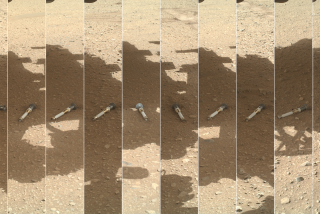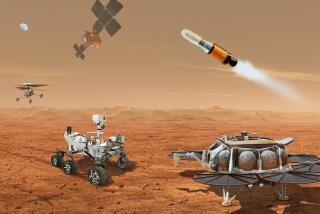How soon can NASA go back to Saturn? This is what has to happen first
Cassini team members at NASA’s Jet Propulsion Laboratory hugged and shed tears in the dark hours of Friday morning after hearing the doomed spacecraft’s final signals as it dove into Saturn’s atmosphere.
But officials made it clear: While it may have been the end for Cassini, it’s not the end for exploring Saturn.
“The discoveries are so compelling that we have to go back,” said JPL Director Michael Watkins, even before the spacecraft’s communications went dark.
Full coverage of Cassini’s Grand Finale »
The discoveries are so compelling that we have to go back.
— Michael Watkins, JPL Director
There are already some proposals in the works for returning to the ringed gas giant or its most charismatic lunar satellites.
NASA is currently evaluating contenders for the next New Frontiers mission — a program for medium-sized missions whose active members include New Horizons (to Pluto), OSIRIS-REx (to the asteroid Bennu) and Juno (to Jupiter). The program picks missions about every five years, and for this round, these are the qualifying targets:
- Send a probe into Saturn
- Visit one of Saturn’s “ocean worlds,” Titan or Enceladus
- Retrieve a surface sample from a comet
- Retrieve a sample from the moon’s south pole
- Explore the strange Trojan asteroids that share Jupiter’s orbit around the sun
- Land a space probe on Venus
It’s actually thanks to Cassini that Saturn’s two moons are on that list, Jim Green, director of the Planetary Science Division at NASA headquarters in Washington, said in an interview.
“Cassini was so successful in demonstrating some really spectacular and surprising moons of Saturn that … we decided to add them as targets,” he said.
Cassini discovered that Titan is a land of methane lakes, full of complex organic compounds, and that icy Enceladus is a tiny water world, hiding a subsurface ocean full of salts. These two moons alone have helped refine and redefine our ideas of what it means to be a potentially habitable world.
But including those two ocean worlds in the running does make the playing field more crowded. Twelve mission proposals have already been submitted to NASA for evaluation, Green said, though he would not say which potential targets those proposals focused on.
Around November, the proposals that make the cut will be moved on to Phase A, where they’ll be studied for about a year. In 2019, one of the original 12 will be selected to become a full-blown mission. That mission will have to launch by the end of 2025 at the latest.
While Saturn takes up at least a third of the potential mission targets listed, it’s in for some stiff competition. The European Space Agency’s Rosetta mission whet scientists’ appetite to get up close with a comet. A piece of lunar mantle would be a scientific coup. Understanding Venus could help us better understand Earth. And the Trojans hovering around Jupiter could reveal much about the gas giant’s origins, Green added.
“We have so many things to do in the solar system — and although Saturn is on everyone’s mind at the moment, each and every one of these [potential targets] are going to provide us absolutely spectacular sets of data,” Green said. “But we’ll only be able to do one next. So one out of 12 proposals will be the one we’ll fly … the best team will win.”
Follow @aminawrite on Twitter for more science news and “like” Los Angeles Times Science & Health on Facebook.
MORE ON THE CASSINI MISSION
Cassini, the NASA spacecraft that expanded the search for life beyond Earth, dies in Saturn’s sky
‘OK. Let’s do it!’ An oral history of how NASA’s Cassini mission to Saturn came to be
See Enceladus set behind Saturn and Cassini’s last view of the ringed planet
As NASA’s Cassini mission flames out over Saturn, scientists mark bittersweet end of mission







